We left Hong Kong to head for Guilin and the Li River area. As soon as we were through immigration, just a few meters across the border, all sign-posts changed back from proper English into the funny Chinese variety that we’d started to miss over the last few days. At the station it turned out all the trains to Guilin were booked full so we ended up buying first class which was the only thing available – had our own cabin and bathroom on the train, and in fact much more space than we’d actually had in the room where we stayed in Hong Kong last few nights! Once in Guilin we only stayed one night, enough to book a cruise down the Li river to Yangshuo for the next day. The highlight for Guilin was watching Edel skillfully butter toast with chopsticks in the hotel breakfast buffet 😀
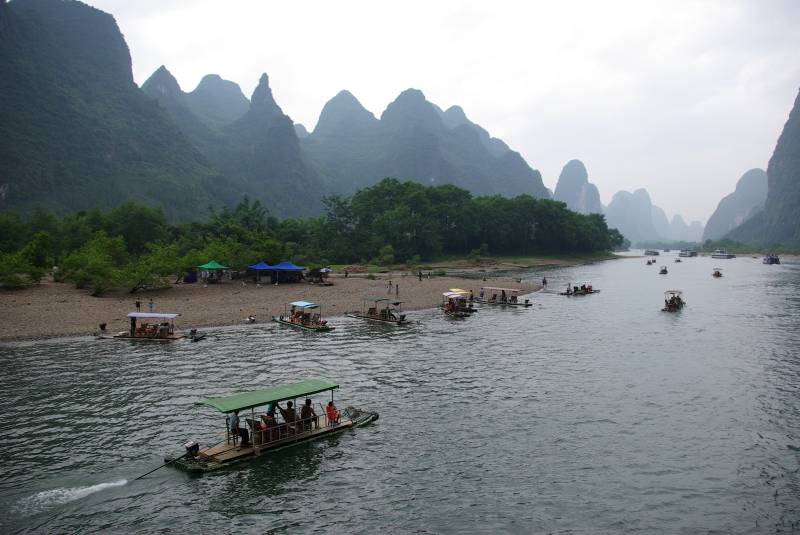
On the Li river.
On the Li river the next day – I hated myself a bit for booking an organized group tour, wearing a colourful panda sticker and following the guy with the panda flag, but there were no easy alternatives short of building our own boat.. When the guide went through all the cringy group-tour things..”Are you all having a good time?” (..crowd: “mumble…“, guide: “I can’t hear you!…“) and having everyone rehearse pronouncing his name I was gnawing at my wrists, but Edel stopped me just in time and I feel much better now.. Also on the negative side; the food on the boat was positively diabolical and not worth missing a second of the scenery for, but the less said about it the better. On the positive side; this is some of the most stunning limestone scenery we’ve ever seen anywhere – hundreds of craggy oddly shaped forested peaks jutting up from the flat flood-plains and rice fields, with tall strands of bamboo hanging out over the river-side. Many of the peaks are named after their shape in typical Chinese fashion with imaginative or poetic names like “Four dragons watching a kitten play under a banyan tree…” etc., but you’d need imagination beyond that of mortals to make it out. The river was busy – a long string of 100-passenger boats with observation decks spaced about 50 meters apart as well as many smaller bamboo rafts.

Sunrise view over the Yangshuo carst landscape.
In the village Yangshuo where the boats drop people we checked in to a cozy hotel in the quiet side of town where we stayed for five nights. The restaurants in Yangshuo had some of the most exotic items we’ve seen on a menu so far – one place we went back to a few times had dog, bamboo rat, pigeon and pig brain/stomach/feet/lung…though we only ventured as far as stuffed river snails and some small crunchy river prawns that are eaten with the shell. We took a cooking lesson one day and made beer fish and other local specialties though nothing too weird – they did take us to the market beforehand though where we saw dogs in cages waiting for the chop chop (..plus half a dog hanging from a hook) and piles of turtles and frogs in sacks. I didn’t see a pangolin or anything else that I could identify as endangered at least though.
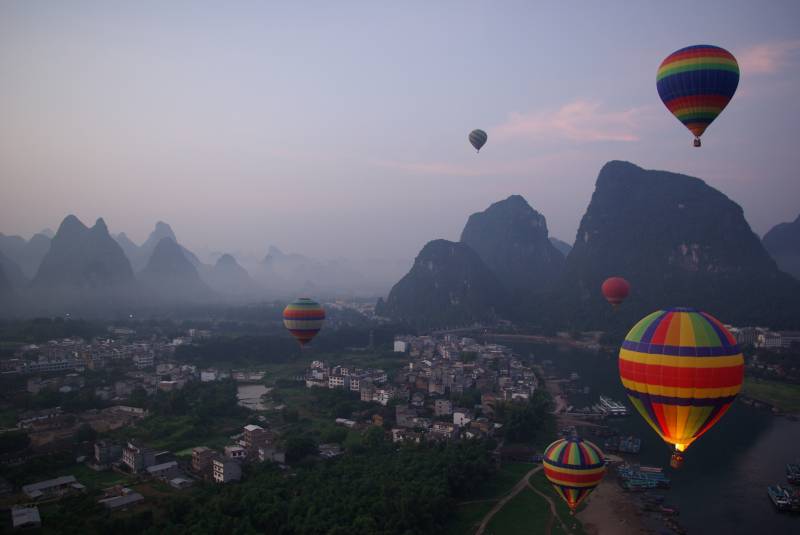
Hot air balloons over Yangshuo at dawn.
One of the days in Yangshuo I went up in a hot air balloon for sunrise (Edel stayed behind as she’s slightly more afraid of heights than I am of early mornings). It was my first time in a balloon – it seems a great way to fly and takeoff is smooth and only takes a couple minutes, after which you spend hours trying to land somewhere depending on where the wind happened to blow you that particular day, while standing up with your head inches away from a three meter flame next to what looks like a very flammable material which is all that separates you from falling to your death half a kilometer below. Bit spooky at first as you’re very exposed in the little basket, but nice once getting used to it and the views were incredibly beautiful and unreal – more and more limestone peaks visible as we were rising higher, the serpentine turns of the river and the red sun rising through the thin rims of mist hanging over the peaks in the morning. I snapped a billion photos (..which also helped to avoid looking down). We were just under a kilometer up in the air at the highest, then for the landing… The driver (balloonist? ballooneur?) tried quite a number of times to nail a spot that wasn’t in the power-lines, on the road or in a flooded rice-field while the yellow-overall ground crew was racing around below on the ground. We eventually landed in a muddy rice field after a close shave with a roof-top.
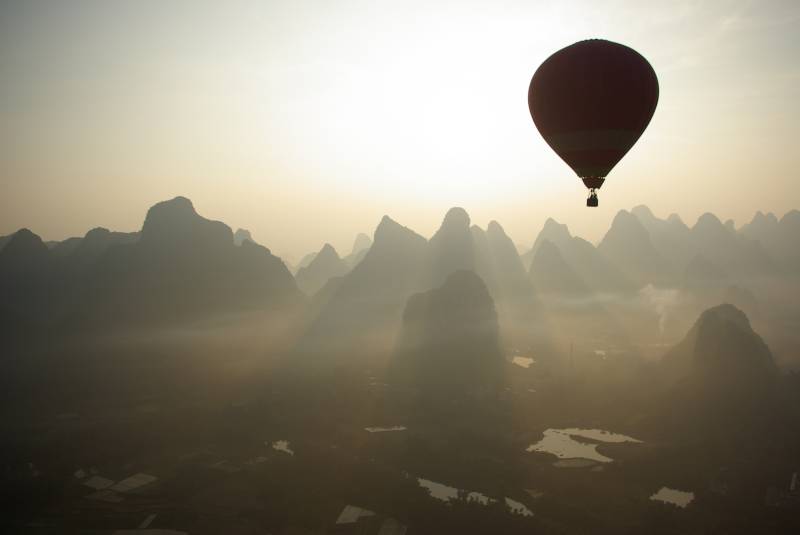
Early morning light over Yangshuo.
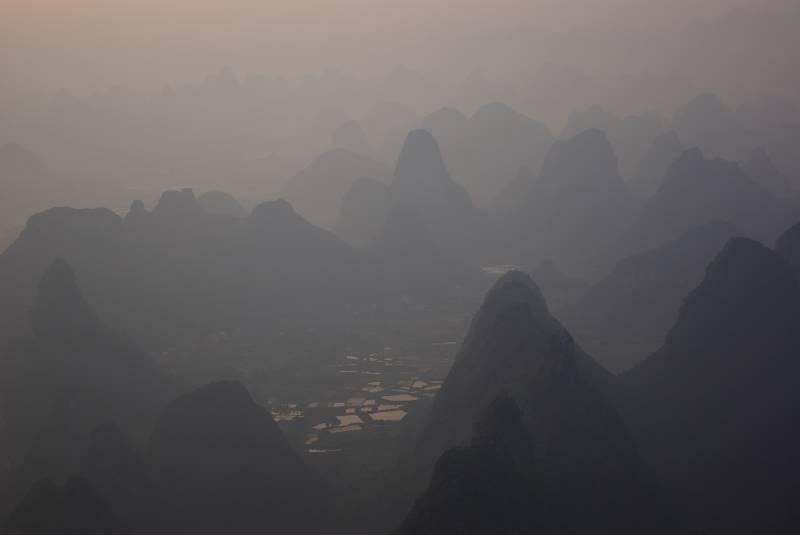
Yangshuo dreamscape.
Other excursions around Yangshuo; we climbed a couple of the smaller peaks around town for the view, and went to watch cormorant fishing one evening. It’s a funny tradition – a fisherman goes out on a small bamboo raft after dark together with half a dozen birds – the birds have rings around their neck to stop them from swallowing the fish they catch, and once they’ve caught a few the fisherman picks them up and gets them to cough up the fish into a basket. Apparently they get to eat every 7th fish, or else they refuse to work! Very inventive, and it’s amazing to see what efficient fishing machines those things are. On the last day we went biking the countryside around Yangshuo, really cute with rice fields, little villages and more craggy limestone peaks everywhere. A nice villager couple out picking fruit gave us a bunch of a strange one we still haven’t found the name for. When we gave them a small bill to say thanks they first didn’t want to accept it, then gave us another really big pile – were eating them the whole rest of the day and gave some to other travellers we met as well. In one spot we hopped on a bamboo raft to go down one stretch of a smaller river – it turned out to be a real tourist-trap complete with people selling photos of you going down the tiny rapids. Two seconds into the trip the rafts-man (who spoke no English except “Hello”) pointed to his belly to indicate he was thirsty or hungry and ten seconds later the first out of an army of rafting drink-sellers wanted us to buy a beer for the captain when we ourselves didn’t want anything. I gave him some money and he bought himself a coke, finished it, burped loudly and threw the empty can straight in the river! I just don’t get it..some part of him must have figured out that he has a salary only because people come from all over to see this beautiful river so why turn it into a garbage heap… We didn’t share a language of course, but hopefully he’ll remember our looks of utter disgust long enough not to do it again for a while.
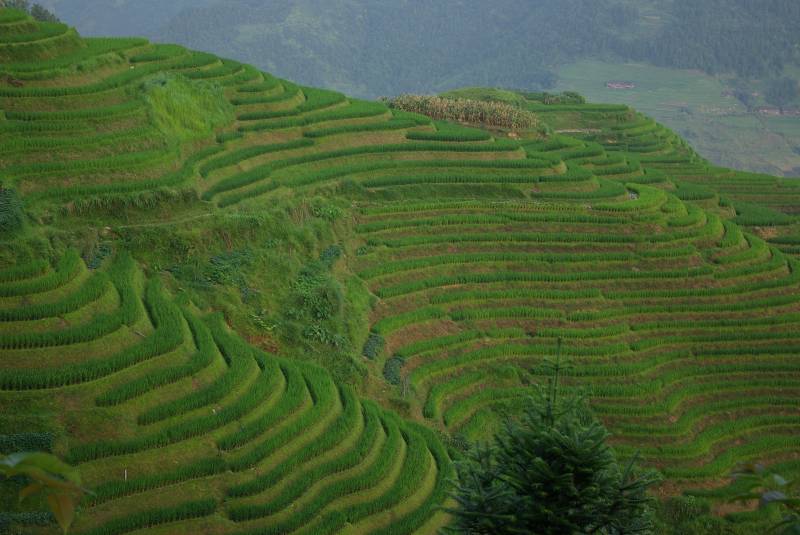
Longji terraced rice fields.
Next morning we headed north – bus back to Guilin, another bus to Longshang, and another bus again to a small village called Ping-An in the Longji area (the southern end of a mountainous ethnic autonomous region) which is famous for some of China’s finest terraced rice-field scenery. It felt like we were getting back to the type of traveling we enjoy best, being the only tourists on the local bus to get there. A woman on the bus who’s 14 month old baby waved at us for 20 kilometers straight started talking to us and she ran a small hostel where she invited us to stay. It was quite a walk uphill in the rain with the big bags once we got off the bus where the road ended, and when we finally did get there it turned out the room had been rented out while she was away. She was really apologetic about it the poor woman, but luckily her friend who also ran a family hostel had a room just another small bit up the hill. The owners there didn’t speak any English at all (though they did have something resembling it on their menu card) but we got on fine with sign language for the three nights we stayed there.
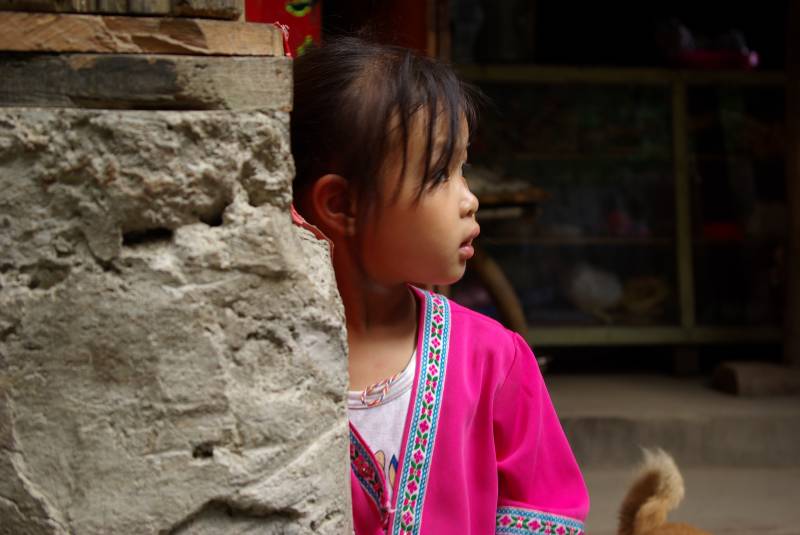
Girl in Longji village.
We spent our days in Ping-An doing short walks around the area. The area is stunning with the hills landscaped into perfect contour lines for terraced rice fields over many centuries – very green with some strands of bamboo here and there on the hill-sides. The villages are really charming with dark wooden houses and bright yellow corn cobs or red chillies lying out to dry everywhere. Ping-An has a bit of tourist development, and sees some day-trips from Guilin, but another village a little further (called Longji like the area) is completely traditional. As we walked through there we were met by some really cute kids who wanted to look at every single photo we had in our camera.

Corn cobs in Longji village.
From Longji we headed back to Guilin to catch a bus back to Hong Kong and spend a couple nights in Macau before flying to Japan. We spent a few hours idling in Guilin before the bus, walking around town and checking out the restaurants with live animals, bamboo rats and turtles, in cages waiting outside. The night-bus to Hong Kong was a new experience also – actually had real bunk beds inside it in three rows…though of course the beds were about 10cm shorter than I am..one of the few times Edel slept better than me on a bus.

Ducks in a Longji rice field.
